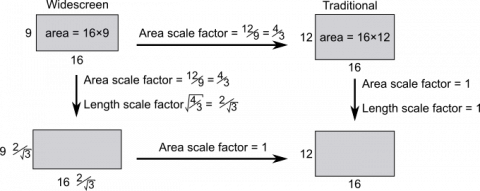Televisual technology
If a new and an old television have screens of the same area, what is the ratio of their widths?
Problem
Traditional television screens have a width : height ratio of $4 : 3$.
Widescreen televisions have a width : height ratio of $16 : 9$.
If a traditional screen and a widescreen have the same area, what is the ratio of their widths?
If you liked this problem, here is an NRICH task which challenges you to use similar mathematical ideas.
Student Solutions
Answer: $\sqrt 3 : 2$ (or $\sqrt{12}:4$)
Using one unknown
Image

Image

Ratio of widths is $4k : 16 = k:4$
Areas are equal so $12k^2 = 144 \Rightarrow k^2 = 12$
So $k=\sqrt{12} = 2\sqrt3$
Ratio of widths is $2\sqrt3 : 4 = \sqrt3 : 2$
Using two unknowns
Image

Ratio of widths is $w:v$
Areas are equal so $\frac34w^2=\frac9{16}v^2$
$\frac34w^2=\frac9{16}v^2\Rightarrow 12w^2=9v^2 \Rightarrow 4w^2 = 3v^2$
So $w^2:v^2 = 3:4$
So $w:v = \sqrt3:\sqrt4 = \sqrt3 : 2$
Using scale factors
Start with both televisions the same width:
Image

Area scale factor between the two TVs:
Image

Enlarge the widescreen TV so that the area scale factor is 1:
Image

Ratio traditional width : widescreen width is $1:\frac2{\sqrt3} = \sqrt3:2$
